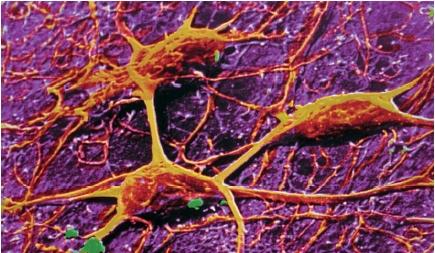The human body is fascinating for both teachers and students. Every student has a body so making real-life connections is a cinch. Unfortunately, the state standards goes into way too much depth on only a few systems, instead of taking a broader spectrum approach. Below are some great teaching resources to teach about the human body.
Note--Saw some really great ppts from Ryan Murphy. I love the idea of introducing the nervous/endocrine system by "scaring" the kids (popping a balloon) to explain the effects of adrenaline.
1. Cells, Tissues, and Organs
2. The Cardiovascular System
3. The Digestive System
4. The Endocrine System
Ideas/Stories to Discuss:
"A wide variety of physiological processes are carried out unconsciously by the endocrine system through chemical messengers called "hormones." The endocrine system is a collection of glands that produces these hormones, which are necessary for normal bodily functions. The hormones regulate metabolism, growth and sexual development. These glands release the hormones directly into the bloodstream, where they are transported to organs and tissues throughout the entire body."
- purpose is COMMUNICATION (akin to the mail system; whereas, the nervous system is like e-mail).
- Pancreas--Insulin/Glucagon (Homeostasis--balance) & Type II Diabetes
- Thyroid--Goiters & iodine; hypo- and hyper-; my story
- Estrogen & Testosterone
- Testicular cancer, doping, Livestrong, and Lance
- adrenaline--flight or fight response
- latest news--endocrine disrupters exposure and diseases (obesity, diabetes, cancer): http://www.nytimes.com/2013/01/20/opinion/sunday/kristof-warnings-from-a-flabby-mouse.html?_r=0
- stem cell research to generate new insulin-secreting pancreatic cells: http://www.sciencedaily.com/releases/2013/01/130110121022.htm
- Steroid abuse: http://www.endo-society.org/advocacy/policy/upload/Steroid-Abuse-Position-Statement-w-Header.pdf
https://docs.google.com/folder/d/0BxAJgJ5OqE-Gc0MySzVFQzQ5WG8/edit?usp=sharing
Lesson Plan and Activity Ideas:
- The Organ Trail (poster): http://sciencespot.net/Pages/otrail.html
- Homeostasis: http://www.lessonplansinc.com/lessonplans/homeostasis_ws.pdf
- Homeostasis Lab Simulation (Insulin/Glucagon):
- http://www.lessonplansinc.com/lessonplans/feedback_mechanism_lab.pdf
- Endocrine System (basic but thorough): http://mhs.mcsnc.org/UserFiles/Servers/Server_2082346/File/medscience/Medical%20Sciences%20I/P%20Endocrine%20System%20%20M.pdf
- Also check out: webmd and www.endocrine.org
- http://www.gen.emory.edu/medweb/medweb.endocrinology.html
- http://school.discoveryeducation.com/teachersguides/pdf/lifescience/ul/thbs_the_endocrine_system_tg.pdf
- http://health.howstuffworks.com/human-body/systems/endocrine
- Endocrine System analogy to the mail: http://www.teachengineering.org/view_lesson.php?url=collection/cub_/lessons/cub_human/cub_human_lesson07.xml (for 3-5th grade but very applicable for higher grades too)

Nervous System Ideas:
Create a poster or build a model of the nervous system, a neuron, the brain. Have students act out the depolarization of the neuron. Have the students play neurologists to diagnose different case studies.

Cool links on Nervous System facts and lessons:
http://faculty.washington.edu/chudler/facts.html
http://www.med.harvard.edu/AANLIB/home.html
http://www.emc.maricopa.edu/faculty/farabee/BIOBK/BioBookNERV.html
Interactive map: http://www.innerbody.com/image/nervov.html
http://www.accessexcellence.org/AE/AEC/AEF/1994/walker_mapping.php
http://www.accessexcellence.org/AE/AEC/AEF/1995/shepley_roses.php
http://faculty.washington.edu/chudler/chmodel.html
http://biology.arizona.edu/sciconn/lessons2/renfro/lesson_1.htm
http://biology.arizona.edu/sciconn/lessons2/renfro/lesson_2.htm
http://biology.arizona.edu/sciconn/lessons2/renfro/lesson_3.htm
http://www.scienceclarified.com/Mu-Oi/Nervous-System.html
Wow! http://www.wellcome.ac.uk/Education-resources/Education-and-learning/big-picture/all-issues/inside-the-brain/index.htm
Wow! Check out these lesson plans: http://outreach.mcb.harvard.edu/lessonplans_S05.htm
Great activities!
- http://www.bioedonline.org/resources/files/1_pre_BLCh_MessengerSystem.pdf
- http://www.bioedonline.org/resources/files/2_BLCh_Neurons.pdf
- http://www.bioedonline.org/resources/files/3_BLCh_ConductingSignals.pdf
- http://www.bioedonline.org/resources/files/5_BLCh_CrossingTheGap.pdf
Great memory game: http://ngm.nationalgeographic.com/games/memory-game
 |
| Cool trick to do with students. You can also "scare" them with a loud sound to show how quickly their body responds to a stimulus. Tons of optical illusions and brain teasers to use for fun. |



keep it up!
ReplyDeleteSpecialists are the craftsman and they need to act as indicated by the circumstance and here is easy to browse https://residencypersonalstatements.net/blog/2015/12/22/interventional-radiology-fellowship-personal-statement for good work. Being a craftsman you need to consider the enjoying and disdaining of the general population and perform in this base.Keep it up
ReplyDelete